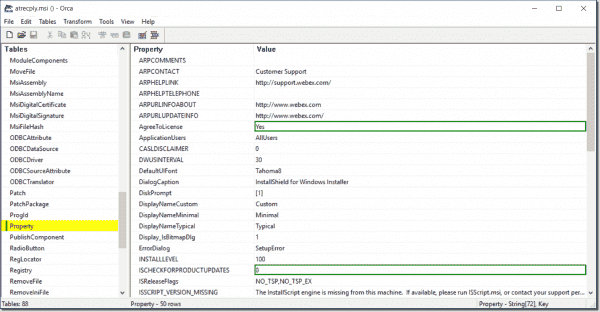

He will click on the Teams icon on the desktop and invokes the machine-wide installer, which by now is at least a year old, it will probably work just fine, but will not support any new features unless it starts auto updating, which it should as long as Microsoft supports that version of the Machine-wide installer. But lets say a year or two from now the user leaves the company and a new user logs in. That will work just fine, automatic updates for the users install.
#Webex teams msi update#
The machine wide installer does not get updated by Office 365 ProPlus update as far as I have observed, nor does it need to since at that point the user has clicked on the teams icon on the desktop and the teams machine wide installer has installed into the users profile the same version which WILL get updated using Office 365 ProPlus update.
#Webex teams msi install#
Click CLOSE to finish the deploy MS Teams using SCCMĪnoop, You are correct the teams machine-wide install for new builds works well, we have deployed it in our enterprise successfully, although I used a file version detection method.Create a deployment alert when the threshold is higher than the following: Disabled Content (1):.Create a deployment alert when the threshold is lower than the following: Disabled.
#Webex teams msi software#
Generate System Center Operations Manager alert when a software installation fails: Disabled.Enable System Center Operations Manager maintenance mode: Disabled.Commit changes at deadline or during a maintenance window (requires restarts): Enabled Alerts.System restart (if required to complete the installation): Disabled.When software changes are required, show a dialog window to the user instead of a toast notification: Disabled.User notifications: Display in Software Center and show all notifications.Delayed enforcement on deployment: Disabled User Experience.Application Deployment Types: Windows Installer (*.msi file) Scheduling.Application Name: MS Teams MSI Application.Allow clients to use a metered Internet connection to download content: Disabled Application Settings (retrieved from application in software library).Pre-deploy software to the user's primary device: Disabled.Allow end users to attempt to repair this application: Disabled.Automatically distribute content for dependencies: Disabled Deployment Settings.Use default distribution point groups associated to this collection: Disabled.Collection: All Desktop and Server Clients (Member Count: 1).Click NEXT and Confirm the summary page.Click on the NEXT button on the ALERTS page.Click on the NEXT button on the USER EXPERIENCE page.


This does not change the cloud-based update mechanism.Schedule – As Soon As Possible after the available time The MSI is not used to deploy updates, the client will auto-update when it detects a new version is available from the service.

If a user already has the Teams app installed in the appdata folder, the MSI installer will skip the process for that user. Whenever a user signs into a new Windows User Profile, the installer will be launched and a copy of Teams application will be installed in that user’s AppData folder. The Teams MSI will place an installer in Program Files. This will mainly be used for customers running software distribution products like System Center Configuration Manager. A big ask from some customers, Microsoft has now provided MSI files (both 32-bit and 64-bit) for admins to leverage during bulk deployment of Microsoft Teams to select users or machines.


 0 kommentar(er)
0 kommentar(er)
